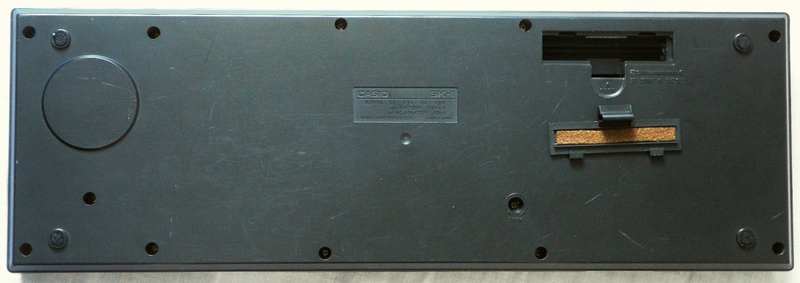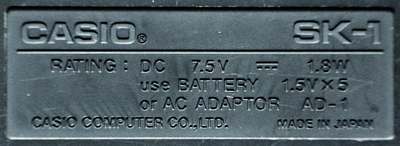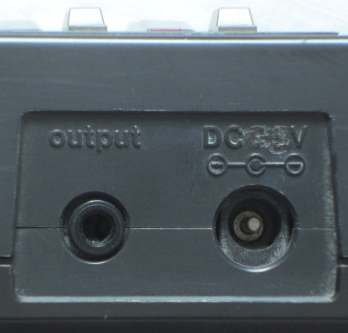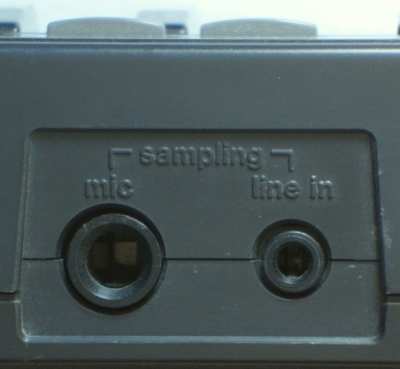|
This keyboard from 1985 was the first affordable home instrument that could record and playback samples. It also includes an additive synthesizer that can generate Hammond- like organ drawbar sounds by mixing sine waves. The rhythms are made from very recognizable semi- metallic blip percussion.
All sounds can be combined with 13 preset volume envelopes. Also the portamento (glide tones) button is really fantastic, because it can make the instrument howl like a theremin when switched into a monophonic mode. The SK-1 has cheesy single finger accompaniments and great digital blip rhythms. The blip percussion sounds very unique and has been used in many tekkno, acid house and pop musics. Very annoying is that the sample-, synthesizer- and sequencer memory is always erased by auto power-off. (As a temporary fix for this, simply start a rhythm and set volume to minimum when you need to make a pause.) This instrument was also released in pink (ultra- rare, seen on Retro Thing site) and another version as Realistic Concertmate-500.

 |
 |
 |
 |
The preset sounds are made from looped medium resolution samples. This instrument has an astonishingly natural sounding piano, that sounds better than many modern mini- keyboards. The 'trumpet' has delayed vibrato and apparently produces an artificial wind noise during its attack phase by a rapidly stuttering zipper noise envelope. The 'brass ensemble' is a nice synth brass. The 'human voice' sounds like a child voice singing "tong"; the entire sample repeats in a loop and slowly fades silent like an echo (ignores key press duration). The 'synth. drums' is a tekkno drum loop sample (alternating base + echoing synth tom) that slowly fades silent (like an echo). All sounds can be combined with the 13 preset envelopes. The vibrato button adds a vibrato (quite weak, about 5Hz) and the portamento button makes the tone bend from one note to another (like a slide trombone, takes about 0.5s) when a note is held and a new key is pressed. (The held old note stays audible unless you select monophonic play by setting the "mode" switch to "solo 1" or "solo 2".) You can play fantastic theremin-like howling effects this way.
The rhythms sound quite unique due to its digital blip percussion; they were already used e.g. in various early acid house musics. The drums are made from unique rough and blippy digital waveforms (possibly these are extremely low- res loop samples with decay envelope). The cymbals employ a rough and semi- metallic digital waveform. Annoying is that the tempo control has only 14 steps; thus despite their range is quite wide, they tend to be either too coarse in the fast or the slow range depending on the selected preset rhythm
When the 'mode' switch is set to 'chord', all keys play single finger accompaniments (with rhythm, 1 chord per key - a similar concept like the chord button field on Casio PT-30, "nc" mutes accompaniment). The accompaniments consist of a monophonic e-bass line and a (monophonic?) sort-of e-piano; they all sound cute and cheesy and most contain typical arpeggio patterns. There is no manual chords mode (without rhythm). With accompaniment you can not play the main voice, but you can record a chord sequence in the built-in sequencer and then play to it. But due to the memory gets erased by auto-power-off, the sequencer is unfortunately almost useless despite it can be edited and records on 3 individual tracks.
The synthesizer feature is great for organ tones and gentle pad sounds,
although it can not be programmed in realtime. To program a timbre, press
'synthesizing'. A continuous sine wave tone starts now. You can now use
9 of the white keys to change the timbre; each key behaves like a Hammond
organ drawbar and adds an overtone; the more often you press it (up to
14 times), the louder turns the overtone. You can not reduce the overtone
volume again, but only clear all overtones by pressing 'synthesizing' again.
When the timbre is finished, press the blue button in the preset sound
row to select it. You can add a preset volume envelope for it by
pressing 'envelope select' followed by a black key. The envelopes are slow
and sound quite similar; short ones play a fixed time (0.15s?) and then
end with an audible click.
hardware detailsThe Casio SK-1 was the first SK-series instrument. It is based on the "OKI M6283-01, 6X07" CPU with 32KB ROM "NEC D23C256EAC 011" and 16KB DRAM (2x "NEC D4168C-20").
The analogue hardware contains each a fixed filter for melody (main voice), chord and bass. Because 3 of the 4 polyphony channels can be reused for sequencer or accompaniment, only with 'function' switch in "normal" mode CPU pin 88 PO3 stays hi to route them through the melody filter. In other modes PO3 is lo and instead pin 61 KO15 is hi to route them through bass and chord filter. RAM and ROM are selected through address line A15 and A13. To select RAM, A15+CE+OE must be lo. A13 selects RAM1 (first 22528 bit reserved for demo or sequencer, rest for sampling) if hi, else RAM2 (65536 bit for sampling). A15 hi+CE lo selects ROM. Traktor wrote me that later SK-1 (case date 1988-03) had the CPU M6283-03. This software number apparently has minor bugfixes. E.g. while "loop set" in version 01 (case date 1986-04) always sounds a low blip and after several seconds ends the calculation with a high blip (even when the sample to be processed was very short). Version 03 apparently loops short samples instantly and only sounds one blip. Also the crash behaviour when the power supply gets connected with power switch in "off" position differs. (03 more often comes up with strange crash noises?) keyboard matrixI haven't analyzed this keyboard matrix by myself, but only read the Casio SK-1 service manual, thus there may be still unknown eastereggs. I also fixed some gibber like KO pins falsely named "KC" and wrong button names.
The input lines are active-high, i.e. react on +Vs. Any functions can
be triggered by a non- locking switch in series to a diode from one "out"
to one "in" pin.
|
Successors of the Casio SK-1 include the Casio
SK-5 and
SK-8. These all had
real persistent memory (could even store 4 samples), but unfortunately
the synthesizer and portamento is gone, envelopes work only with sampling
and the drums are different (plain ordinary samples). An odd cross between
both hardware classes was the Casio SK-10
(with variant SK-2). Much info about these instruments can
be found on the internet.
| removal of these screws voids warranty... | ||
 |
||
|
|